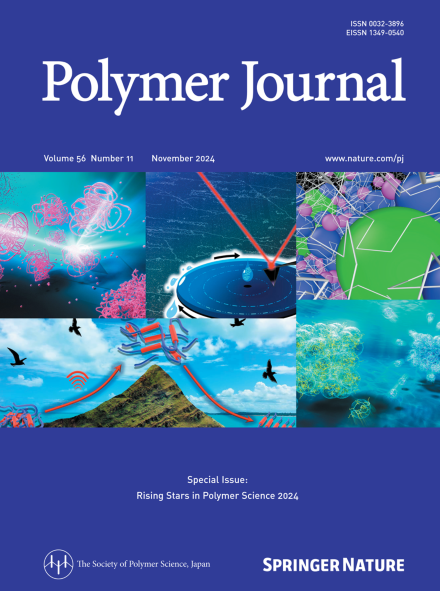Liquid‒liquid phase separation induced by i-motif DNA under molecular crowding conditions
IF 2.7
4区 化学
Q3 POLYMER SCIENCE
引用次数: 0
Abstract
Cytosine-rich sequences can fold into a four-stranded structure called the i-motif. These i-motif-forming DNA sequences are enriched in the promoter regions of cancer-related genes and telomeres, indicating their biological importance. Interestingly, an i-motif-forming DNA oligonucleotide derived from telomeres was reported to undergo liquid‒liquid phase separation (LLPS), suggesting that i-motifs regulate cellular processes involving gene expression via LLPS. However, it is still unclear whether i-motifs are able to undergo LLPS under physiological conditions because i-motif structures are thermodynamically stable only under acidic conditions. In this study, we systematically studied the thermodynamics of a series of i-motif-forming oligonucleotides and their ability to undergo LLPS under molecular crowding conditions that mimic the conditions inside cells at various pH values. The thermodynamic analyses revealed that crowding reagents with higher molecular weights stabilize the i-motif structure and increase its pKa. Moreover, we demonstrated that i-motif structures stabilized by molecular crowding undergo LLPS under neutral and even basic conditions. On the other hand, mutated oligonucleotides that do not form stable i-motif structures did not undergo LLPS. These results indicate that i-motif-forming DNAs can robustly and widely undergo LLPS depending on cellular environmental factors such as the solution pH, composition of crowding reagents and degree of molecular crowding in living cells. We showed that various i-motif-forming DNAs undergo LLPS with cationic peptide in acidic conditions. Considering cellular condition, we further investigated LLPS of DNAs in the molecular crowding conditions at physiological pH. LLPS is promoted by molecular crowding conditions at even in basic pH through stabilization of i-motif structure by molecular crowding condition.

分子拥挤条件下i-motif DNA诱导的液-液相分离
富含胞嘧啶的序列可以折叠成称为i基序的四链结构。这些形成i基序的DNA序列富集于癌症相关基因和端粒的启动子区域,表明其生物学重要性。有趣的是,据报道,来自端粒形成i-motif的DNA寡核苷酸进行了液-液相分离(LLPS),这表明i-motif通过LLPS调节涉及基因表达的细胞过程。然而,目前尚不清楚i-motif是否能够在生理条件下经历LLPS,因为i-motif结构只有在酸性条件下才具有热力学稳定性。在这项研究中,我们系统地研究了一系列i基序形成寡核苷酸的热力学,以及它们在模拟不同pH值下细胞内条件的分子拥挤条件下经历LLPS的能力。热力学分析表明,高分子量的拥挤试剂稳定了i-motif的结构,增加了其pKa。此外,我们证明了分子拥挤稳定的i-motif结构在中性甚至基本条件下都会发生LLPS。另一方面,不能形成稳定的i-motif结构的突变寡核苷酸没有经历LLPS。这些结果表明,在活细胞中,形成i-motif的dna可以根据细胞环境因素(如溶液pH、拥挤试剂的组成和分子拥挤程度)广泛而稳定地经历LLPS。我们发现,在酸性条件下,各种i-motif形成的dna与阳离子肽发生LLPS。考虑到细胞条件,我们进一步研究了生理pH下分子拥挤条件下dna的LLPS。即使在碱性pH下,分子拥挤条件也会通过分子拥挤条件稳定i-motif结构来促进LLPS。
本文章由计算机程序翻译,如有差异,请以英文原文为准。
求助全文
约1分钟内获得全文
求助全文
来源期刊

Polymer Journal
化学-高分子科学
CiteScore
5.60
自引率
7.10%
发文量
131
审稿时长
2.5 months
期刊介绍:
Polymer Journal promotes research from all aspects of polymer science from anywhere in the world and aims to provide an integrated platform for scientific communication that assists the advancement of polymer science and related fields. The journal publishes Original Articles, Notes, Short Communications and Reviews.
Subject areas and topics of particular interest within the journal''s scope include, but are not limited to, those listed below:
Polymer synthesis and reactions
Polymer structures
Physical properties of polymers
Polymer surface and interfaces
Functional polymers
Supramolecular polymers
Self-assembled materials
Biopolymers and bio-related polymer materials
Polymer engineering.
 求助内容:
求助内容: 应助结果提醒方式:
应助结果提醒方式:


